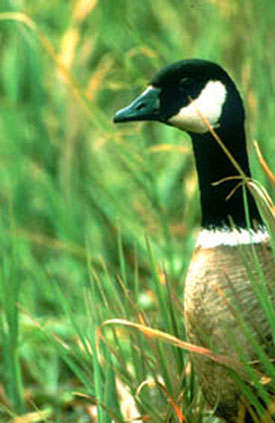Field Guide/Birds/Branta canadensis
Template:Taxobox begin
Template:StatusSecure
Template:Taxobox image
Template:Taxobox begin placement
Template:Taxobox regnum entry
Template:Taxobox phylum entry
Template:Taxobox classis entry
Template:Taxobox ordo entry
Template:Taxobox familia entry
Template:Taxobox genus entry
Template:Taxobox species entry
Template:Taxobox end placement
Template:Taxobox section binomial
Template:Taxobox end
The Canada Goose (Branta canadensis), colloquially Canadian Goose in North America, belongs to the Branta genus of geese, which contains species with largely black plumage, distinguishing them from the grey Anser species. The species name, canadensis, is a New Latin word meaning "of Canada".
The black head and neck with white "chinstrap" distinguish this goose from all except the Barnacle Goose, but the latter has a black breast and grey, rather than brownish, body plumage. There are up to 12 subspecies of this bird, of varying sizes and plumage details, but all are recognizable as Canada Geese.
The small races, for example B. c. minima, are now considered in North America to be a separate species, the Cackling Goose, B. hutchinsonii. The large subspecies, such as the giant Canada Goose, B. c. maxima remain as Canada Goose.
This well-known species is native to North America. It breeds in Canada and the northern USA in a variety of habitats. However, the nest is usually located in an elevated area near water, sometimes on a beaver lodge. The eggs are laid in a shallow depression lined with plant material and down. Males, 8–14 pounds (3.5–6.5 kg), can be very aggressive in defending territory. A pair may mate for life (around 20 years). The female looks virtually identical but is slightly lighter (7–12 pounds, 3–5.5 kg), and has a different honk.
Like most geese, it is naturally migratory, the wintering range being most of the USA. The calls overhead from large groups of Canada Geese flying in V-shaped formation signal the transitions into spring and fall. In some areas, migration routes have changed due to changes in habitat and food sources. In mild climates, such as the Pacific Northwest, due to a lack of former predators, some of the population has become non-migratory. Some migratory populations in temperate climates frequent cities as well, due to convenient, predator-free open spaces. These birds are considered by many to be a nuisance, mainly because of the large volume of feces they produce, and some cities have begun extermination programs against them.
This species has reached western Europe naturally, as has been proved by ringing recoveries, but has also been introduced. The introduced birds are of the largest race, and have established feral populations in Great Britain, The Netherlands and Scandinavia. The birds are also found on the Kamchatka Peninsula in eastern Siberia, eastern China, and throughout Japan.
Semi-tame feral birds are common in parks, and have become a pest in some areas. Interestingly, it is now proved that most Scandinavian and some British birds have established a migration pattern.
These birds feed mainly on plant material. When feeding in water, they submerge their heads and necks to reach aquatic plants, sometimes tipping forward like a dabbling duck. Flocks of these birds often feed on leftover cultivated grains in fields, especially during migration or in winter. They also eat some insects, molluscs and crustaceans.
By the early 20th century, over-hunting and loss of habitat had resulted in a serious decline in the numbers of this bird in its native range. With improved game laws, their populations have recovered in most of their range, although some local populations may still be declining. They have adapted well to urban environments, especially those with well-trimmed lawns and large ponds, such as golf courses and city parks.
The Canada Goose, the Cackling Goose, and subspecies
The Cackling Goose was originally considered to be the same species or a subspecies of the Canada Goose, but in July 1994 the American Ornithologists' Union's Committee on Classification and Nomenclature voted to split the two into two species, making Cackling Goose into a full species with the scientific name Branta hutchinsii.
The AOU has divided the many associated subspecies of both animals:
- Canada Goose
- Atlantic Canada Goose (Branta canadensis canadensis)
- Interior Canada Goose (Branta canadensis interior)
- Giant Canada Goose (Branta canadensis maxima)
- Moffit's Canada Goose (Branta canadensis moffitti)
- Vancouver Canada Goose (Branta canadensis fulva)
- Dusky Canada Goose (Branta canadensis occidentalis)
- part of ‘Lesser complex’ (Branta canadensis parvipes)
- Cackling Goose
- Richardson's Cackling Goose (Branta hutchinsii hutchinsii)
- Bering Cackling Goose (Branta hutchinsii asiatica)—extinct
- Aleutian Cackling Goose (Branta hutchinsii leucopareia)
- part of ‘Lesser complex’ (Branta hutchinsii taverneri)
- (Branta hutchinsii minima)
The distinctions between the two geese have led to a great deal of confusion and debate among ornithologists. This has been aggravated by the overlap between the small types of Canada Goose and larger types of Cackling Goose.
For more information on the subject, see the following:
- Stackhouse, Mark. "The New Goose." [1]
- Angus, Wilson. "Identification and range of subspecies within the Canada and Cackling Goose Complex (Branta canadensis & B. hutchinsii)." [2]
See also
- The Canada Goose was depicted on the 1986 series Canadian $100 note.
- Photo of a Canada Goose avoiding a snapping turtle at predator.
- The 1996 movie Fly Away Home was about Canada Geese.
de:Kanadagans nl:Canadagans ja:カナダガン pl:Bernikla kanadyjska sl:Kanadska gos fi:Kanadanhanhi

